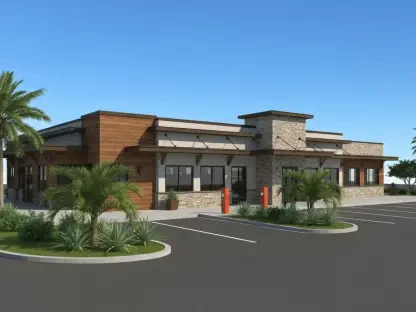In a bustling urban diner at the heart of a major city, a seasoned restaurateur stares at a stack of bills while the dinner rush begins, feeling the weight of every decision. With food prices soaring and labor costs unrelenting, choices about menu pricing and staff scheduling have turned into high-stakes gambles for survival. This scene, replicated in countless establishments across the nation, paints a vivid picture of an industry under siege. How can restaurants, often seen as cornerstones of community and culture, survive when profit margins are thinner than ever? This question looms large for an industry employing over 15.7 million people and facing economic pressures that threaten even the most established players.
The Stakes of Survival in a Struggling Sector
The restaurant industry, with over 1 million outlets nationwide, stands as a vital pillar of local economies, yet it teeters on the edge of financial instability. Beyond the immediate concerns of owners and operators, the ripple effects touch diners, employees, and entire communities that rely on these businesses for jobs and social spaces. Understanding the depth of these challenges is critical, as the sector navigates a perfect storm of declining customer traffic and escalating expenses, driven by broader economic trends like inflation and shifting consumer preferences.
This struggle is not just a business issue; it’s a societal one. When restaurants falter, the impact extends to suppliers, service workers, and the vibrancy of neighborhoods. The urgency to address these pressures stems from the sheer scale of the industry’s role in daily life, making it imperative to dissect the root causes and explore potential lifelines for those caught in the financial squeeze.
Economic Forces Squeezing the Industry
A closer look at the broader landscape reveals a sector battered by multiple headwinds. Inflation continues to drive up the cost of ingredients, with some staples seeing double-digit price increases over recent years. At the same time, customer visits have declined as dining out becomes a luxury many can no longer afford, leaving tables empty even during peak hours.
Compounding this issue is the shift in consumer behavior, with more people opting for takeout or home-cooked meals to save money. These trends, paired with rising operational expenses, create a vicious cycle where revenue shrinks while costs climb relentlessly. For an industry already operating on slim margins, this dynamic poses an existential threat to countless establishments, from small family-run spots to larger chains.
Hard Numbers Reveal a Grim Reality
Data from a comprehensive report by the National Restaurant Association, based on insights from over 900 U.S. restaurants, lays bare the financial tightrope operators walk. Full-service restaurants report a median pre-tax profit margin of just 2.8%, while limited-service establishments manage a slightly better 4.0%. These figures highlight how little room there is for error when every cent counts.
Prime costs—covering food, beverages, and labor—consume a staggering portion of revenue, with limited-service spots spending 65 cents of every sales dollar on these essentials. Labor stands out as the heaviest burden, particularly for full-service venues, where payroll and benefits account for 36.5% of sales. Variations in these costs, influenced by factors like location and average check size, further complicate the picture, showing that no two restaurants face identical challenges.
This granular breakdown of expenses underscores a margin-sensitive environment where even minor fluctuations in costs can wipe out profits. Urban restaurants, for instance, often grapple with higher rent and wages compared to rural counterparts, while high-volume chains may offset costs through scale that smaller independents cannot match. These disparities paint a complex portrait of an industry struggling to find solid ground.
Voices from the Front Lines
Industry experts shed light on the human toll behind these stark statistics. Chad Moutray, chief economist at the National Restaurant Association, emphasizes the need for clear visibility into cost centers like payroll, utilities, and marketing. “Operators must know exactly where their money is going to make informed decisions,” he notes, pointing to data as a lifeline in turbulent times.
Consider the case of a small-town diner owner forced to reduce staff hours after a spike in food prices ate into already thin margins. This decision, while necessary for survival, meant shorter shifts for loyal employees and a diminished customer experience due to slower service. Such real-world dilemmas illustrate the delicate balance between cutting costs and maintaining quality, revealing the emotional and practical weight of financial decisions in this sector.
These stories and insights highlight a broader truth: navigating this margin-sensitive world requires not just grit but also strategic precision. Restaurant owners are increasingly turning to data-driven approaches to identify inefficiencies, yet the personal impact of each choice remains a constant undercurrent, shaping how they adapt to relentless economic pressures.
Strategies to Weather the Storm
Amid these challenges, actionable solutions offer a glimmer of hope for struggling operators. Resources like the National Restaurant Association’s “Analyze Your Operation” worksheet provide a structured way to benchmark financials against industry standards. This tool enables owners to pinpoint discrepancies in areas like labor or food costs, offering a roadmap to adjust operations with precision.
For full-service restaurants, optimizing staff scheduling can make a significant difference, ensuring labor costs align with peak demand periods. Limited-service establishments, on the other hand, might focus on streamlining supply chains to negotiate better prices on ingredients. These tailored strategies address the unique needs of different segments, empowering operators to tackle high costs without sacrificing service quality.
Beyond these tools, a mindset shift toward efficiency is crucial. Regularly reviewing expenses, experimenting with menu pricing, and leveraging technology for inventory management are practical steps that can boost profitability. While no single fix guarantees success, combining these efforts creates a stronger foundation for restaurants to endure an environment where every dollar must be stretched to its limit.
Reflecting on Paths Forward
Looking back, the journey through the restaurant industry’s struggles reveals a landscape marked by razor-thin margins and unrelenting costs. The stark data, expert perspectives, and real-world scenarios paint a picture of resilience tested by economic forces beyond any single operator’s control. Each story and statistic underscores the urgency of adaptation in a sector central to community life.
Moving ahead, the focus shifts to empowering restaurateurs with the tools and strategies needed to navigate these challenges. By harnessing detailed financial insights and embracing targeted operational adjustments, many find ways to stabilize their businesses. The path forward lies in continued innovation—whether through technology, cost management, or reimagined customer experiences—to ensure that restaurants remain vibrant hubs despite the odds.
Ultimately, the industry’s survival hinges on a collective commitment to evolve. Operators who seek out resources, collaborate with peers, and prioritize efficiency often discover new avenues for growth. As the sector moves toward an uncertain future, these lessons in adaptability stand as a beacon, guiding restaurants to not just endure but thrive in a high-cost world.









